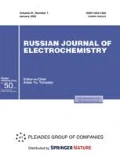Abstract
The hemosorbents made of carbon materials, which are used for hemosorption detoxication, should be indifferent toward blood. Therefore, in the course of hemosorption, it is important to avoid the Faradaic processes, which can change the blood composition. The probability of Faradaic processes depends on the open-circuit potential of activated carbon. This dependence is studied by simulating the detoxication processes. In order to obtain various open-circuit potentials, which are reached after switching-off polarization, the adsorption of cupric ions and t-butanol on the preliminarily polarized hemosorbent (AG-3 activated carbon) is studied. The effective number of electrons, which are transferred in an elementary adsorption act, is determined. The conditions, under which the Faradaic process does or does not proceed, are found.
Similar content being viewed by others
References
Tarasevich, M.R., Elektrokhimiya uglerodnykh materialov (Electrochemistry of Carbon Materials), Moscow: Nauka, 1984.
Lopukhin, Yu.M. and Molodenkov, M.N., Gemosorbtsiya (Hemosorption), Moscow: Meditsina, 1985.
Goldin, M.M., Volkov, A.G., Goldfarb, Yu.S., and Goldin, Mikh.M., J. Electrochem. Soc., 2006, vol. 153, p. J91.
Bansal, R.C. and Goyal, M., Activated carbon adsorption, Roca Raton FL: CRC Press Taylor & Frensis group, 2005.
Chemistry and Physics of Carbon, Radovich, L.R., Ed., New York: Marcel Dekker, 2001, vol. 27.
Marsh, H. and Rodrigues-Reinoso, F., Activated, Carbon., Oxford, UK: Elsevier, 2006.
Tarkovskaya, I.A., Okislennyi ugol’ (Oxidized Carbon), Kiev: Nauk. Dumka, 1981.
Frumkin, A.N., Potentsialy nulevogo zaryada (Zero-Charge Potentials), Moscow: Nauka, 1982.
Bulgakova, N.S., Chaika, M.Yu., Kravchenko, T.A., Polyanskii, L.N., and Krysanov, V.A., Sorbtsionnye i khromatograficheskie protsessy, (Sorption and Chromatographic Processes), 2008, vol. 8, p. 53.
Strelko, V.V., Ukr. Khim. Zh., 1991, vol. 57, p. 1065.
Tarasenko, Yu.A., Reznik, G.V., and Bagreev, A.A., Ukr. Khim. Zh., 1989, vol. 55, p. 249.
Tarasenko, Yu.A., Reznik, G.V., Bagreev, A.A., and Lysenko, A.A., Zh. Fiz. Khim., 1993, vol. 63, p. 2333.
Goldin, M.M., Volkov, A.G., and Namychkin, D.N., J. Electrochem. Soc., 2005, vol. 152, p. E167.
Goldin, M., Volkov, A.G., and Namychkin, D.N., J. Electrochem. Soc., 2005, vol. 152, p. E172.
Dougall, G.J., Hancock, R.D., and Nicolet, M.J., J. S. Afr. Inst. Mining and Met., 1980, no. 9, p. 344.
Yunusov, M.P., Perezdrienko, I.V., Namazbaev, Sh.N., and Molodozhenyuk, T.B., Khim. Prom., 2003, no. 8, p. 382.
Kienle, H. and Bader, E., Aktivkohle und Ihre Industrielle Anwendung, Stuttgart: Ferdinand Enke, 1980.
Strelko, V.V., Dudarenko, V.V., Tarasenko, Yu.A., Senkevich, A.I., and Nemoshkalenko, A.I., Ukr. Khim. Zh., 1986, vol. 52, p. 1157.
Vasil’ev, Yu.B., Grinberg, V.A., Sergienko, V.I., Martynov, A.K., and Bulygina, T.N., Elektrokhimiya, 1988, vol. 24, p. 295.
Frumkin, A., Z. Phys., 1926, vol. 35, p. 792.
Frumkin, A.N. and Melik-Gaikazyan, V.I., Dokl. Akad. Nauk SSSR, 1951, vol. 77, p. 855.
Grafov, B.M. and Ukshe, E.A., Elektrokhimicheskie tsepi peremennogo toka (AC Electrochemical Circuits), Moscow: Nauka, 1973.
Rychagov, A.Yu., Urisson, N.A., and Volfkovich, Yu.M., Russ. J. Electrochem, 2001, vol. 37, p. 1172.
Idrisova, S.F. and Grinevich, V.I., Izv. Vyssh. Uchebn. Zaved., Khim. Khim. Tekhnol., 2009, vol. 52, p. 41.
Dyatkina, S.L. and Damaskin, B.B., Elektrokhimiya, 1978, vol. 14, p. 461.
Lopatkin, A.A., Teoreticheskie osnovy fizicheskoi adsorbtsii (Theoretical Basis of Physical Adsorption), Moscow: Mosk. Gos. Univ., 1983.
Author information
Authors and Affiliations
Corresponding author
Additional information
Original Russian Text © Mikh.M. Goldin, B.M. Grafov, G.R. Garaeva, A.D. Davydov, M.M. Goldin, V.A. Kolesnikov, 2013, published in Elektrokhimiya, 2013, Vol. 49, No. 2, pp. 121–128.
Rights and permissions
About this article
Cite this article
Goldin, M.M., Grafov, B.M., Garaeva, G.R. et al. Simulation of detoxication processes on ideally polarizable porous carbon materials. Russ J Electrochem 49, 107–114 (2013). https://doi.org/10.1134/S1023193513020079
Received:
Published:
Issue Date:
DOI: https://doi.org/10.1134/S1023193513020079




